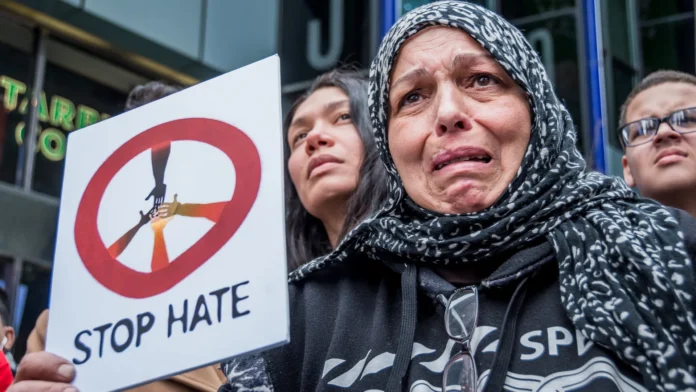Doesn’t it seem odd that anti-Muslim bigotry is categorised as a species of racism?
Despite scholarly debates challenging the narrow definition of racism solely based on visible
characteristics and biological inferiority, many still associate the term with these concepts.
Racism necessitates perceiving the targeted group as a distinct ‘race,’ either based on physical appearance or shared ancestry. However, Muslims in India do not align with these perceptions; they share physical features with other Indians and are not regarded as a separate ethnic group.
Indian Muslims being identified by religion rather than physical traits doesn’t negate the possibility of categorizing discrimination against them as racism. Tariq Modood, a politicalscientist highlights that religions can be racialized, akin to Western Islamophobia and anti- semitism, which he terms as ‘Europe’s oldest racisms.’ These forms of discrimination are ‘culturalist,’ not grounded in biological beliefs about Jews or Muslims but in the perception of an inherent inferior or villainous nature attributed to the group, used to justify oppressive practices within unequal power dynamics.
Currently, there are concerning parallels to Nazi propaganda in depictions of Muslims in India. They are accused of engaging in ‘love jihad’ to lure Hindu women and of intentionally spreading disease during the COVID-19 pandemic, termed ‘corona jihad’. These accusations are widespread on social media and popular television news channels, accompanied by calls for boycotting Muslim-owned businesses.
The discrimination experienced by Indian Muslims can be understood through a lens of racism, despite lacking some typical features like color-coding or lineage ties. This perspective suggests specific remedies, as Indian Muslims are recognized as a religious community under a secular system granting them autonomy over personal laws, yet this hasn’t alleviated socioeconomic disparities or discrimination.
Looking at the scenario back in 2020 when the muslim community was protesting against NRC CAA, mobs descended in the capital of India and wreaked havoc for several days. In the aftermath of the incident, major destruction was witnessed at large. In a locality where muslim homes were burned down and destroyed, the other residents were encouraging the massacre that was happening.
Where the protest was peaceful and people were in harmony, singing patriotic songs, chanting patriotic slogans, hoisting Indian flags, and giving speeches on solidarity and secularism, demonstrates the loyalty of the muslims to their country and still being portrayed as infiltrators.
Recalling two major instances of intercommunal violence in recent Indian history to see what makes these attacks distinct and, thus, more terrifying: the Sikh massacres in Delhi in 1984 and the Muslim pogroms in Gujarat in 2002.
The 1984 anti-Sikh violence stemmed from a separatist movement in Punjab led by Jarnail Singh Bhindranwale, who sought refuge in the Golden Temple. Prime Minister Indira Gandhi ordered a military operation to remove Sikh fighters from the temple, resulting in over 500 deaths. In retaliation, two Sikh guards assassinated Gandhi in October 1984, triggering widespread violence that left 2,800 Sikhs dead in three days.
In 2002, Gujarat witnessed violence similar to past events. It began with a train fire on February 27, killing 59 Hindu pilgrims returning from Ayodhya. A Hindu mob had demolished the Babri Mosque there 10 years earlier, claiming it was on a Hindu temple site. Initially ruled as accidental, the train fire was later attributed to Muslims, sparking Hindu retaliation. Over 1,000, mostly Muslims, were killed in the ensuing violence.
In all instances, it was alleged that the police had abandoned their oversight responsibilities by either doing nothing or, in certain situations, encouraging the murders. Extreme acts of violence that had never before been witnessed in Indian communal conflicts also characterized both incidents.
Both the 1984 anti-Sikh riots in Delhi and the 2002 Gujarat riots shared allegations of
government involvement. In Delhi, Congress leaders were accused of aiding rioters, with
accusations of government complicity. A fact-finding team found evidence of organized planning by Congress politicians. Sajjan Kumar, a prominent MP, was later sentenced to life in prison for inciting violence against Sikhs. In Gujarat, the BJP government, led by Narendra Modi, faced similar accusations. Our PM was accused of failing to stop the violence and indirectly supporting Hindu rioters. Although cleared by a Special Investigation Team in 2012, rights groups still claim he tacitly supported the rioters, echoing the Supreme Court’s comparison of his government to Nero, who fiddled while Rome burned.
The anti-Muslim attacks in Delhi exhibited all these traits. The Sikh massacres and Gujarat
pogroms were triggered by alleged wrongdoings by targeted communities, while anti-Muslim violence in Delhi wasn’t retaliatory but seemed to be based solely on the victims’ identity and peaceful protest against discriminatory laws. This signals a disturbing shift in Indian history, where Hindu mobs, supported by the government, now attack minorities without apparent provocation.
To my surprise, being included in a minority community, muslims are a threat to other
communities and it suggests that the future is now darker and more terrifying than it has ever been for minority populations in India.




